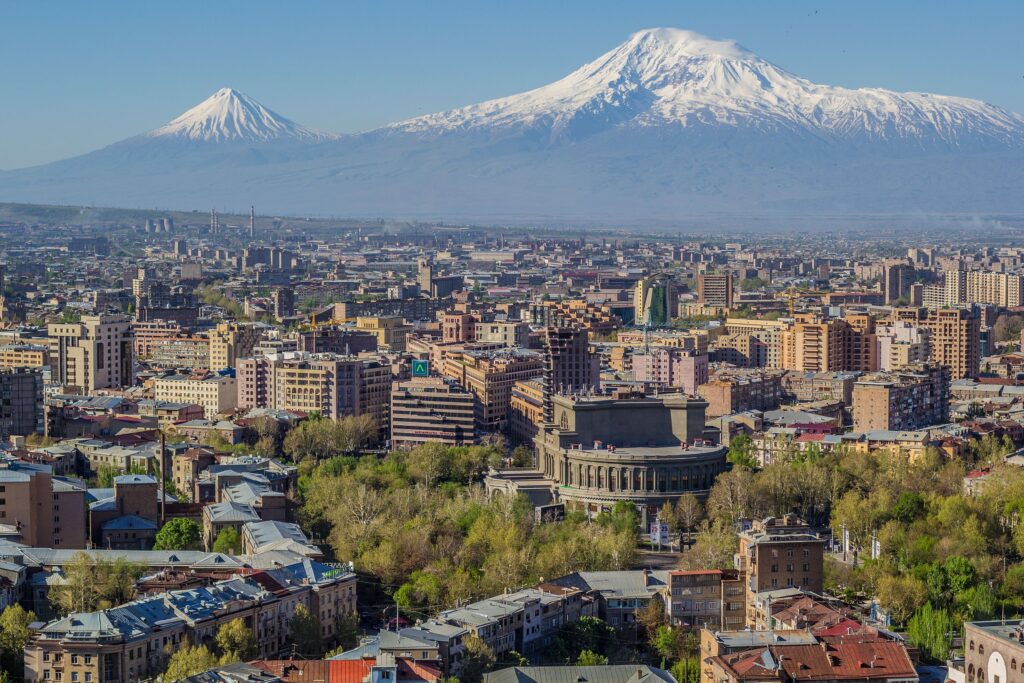Quick facts about Armenia:
- Population: Approximately 2.9 million people.
- Capital: Yerevan.
- Area: Around 29,743 square kilometers.
- Currency: Armenian Dram (AMD).
- Language: Armenian.
- Geography: Landlocked country in the South Caucasus, featuring diverse landscapes, including mountains, valleys, and the stunning Lake Sevan.
Fact 1: Armenia is associated with the biblical Mount Ararat
Armenia is closely associated with the biblical Mount Ararat, an iconic and symbolic mountain in various religious traditions. According to the Bible, it is believed to be the resting place of Noah’s Ark after the Great Flood. Mount Ararat is a prominent landmark visible from many parts of Armenia, contributing to its cultural and spiritual significance. Despite being located in modern-day Turkey, Mount Ararat holds a special place in the hearts and identity of the Armenian people. The image of Mount Ararat is often found in Armenian art, literature, and national symbols.

Fact 2: More Armenians live abroad than in Armenia
There are more Armenians abroad as many Armenians were forced to leave because of persecution and killings in the Ottoman Empire. The tragic events commonly referred to as the Armenian Genocide occurred during the final years of the Ottoman Empire (1915-1923). Preconditions for this genocide included political instability, nationalistic sentiments, and discriminatory policies against the Armenian population. Key factors include:
- Nationalism and Political Turmoil: The declining Ottoman Empire faced rising nationalism and sought to homogenize its population. This atmosphere contributed to discriminatory policies against ethnic and religious minorities.
- Deportations and Massacres: In 1915, the Ottoman government initiated mass deportations and systematic massacres of the Armenian population. Armenians were forcibly removed from their homes, subjected to brutal conditions during deportations, and many were killed.
- Genocidal Intent: Scholars and historians widely consider the events as a genocide due to evidence of systematic planning, mass killings, and intent to destroy the Armenian population.
- International Response: The genocide sparked international condemnation at the time, and it remains a topic of historical and political significance today. However, modern-day Turkey disputes the term “genocide,” acknowledging the deaths but attributing them to wartime conditions.
The consequences of the Armenian Genocide include a significant loss of life, forced emigration, and the establishment of a sizable Armenian diaspora, with many communities forming in countries around the world. The recognition of the events as a genocide remains a sensitive and debated topic on the international stage. Turkey still denies these events.
Fact 3: Armenia was the first country to adopt Christianity
Armenia holds the distinction of being the first country to officially adopt Christianity as its state religion. This historic event took place in the year 301 AD, making Armenia one of the earliest nations to embrace Christianity. The catalyst for this decision was Saint Gregory the Illuminator, who is credited with converting King Tiridates III and subsequently the Armenian people to Christianity.
Etchmiadzin Cathedral, located in Vagharshapat (Etchmiadzin), is recognized as the first cathedral built in Armenia and is considered the oldest state-built church in the world. Erected in the early 4th century, Etchmiadzin remains a significant spiritual and cultural symbol for Armenians, reflecting the nation’s deep-rooted Christian heritage.

Fact 4: Armenia has its own alphabet
Armenia is home to a unique and ancient script, as well as neighboring Georgia with its own alphabet (see 10 intereting facts about Georgia). Created by Saint Mesrop Mashtots in 405 AD, the Armenian alphabet consists of 38 letters, each representing a distinct sound. The creation of the alphabet played a crucial role in the preservation and dissemination of Armenian culture, literature, and religious texts.
The Armenian alphabet has remained largely unchanged over the centuries and is still in use today. Its distinctive characters and historical significance make it an integral part of Armenia’s cultural identity and linguistic heritage.
Fact 5: The oldest winery has been found in Armenia
Armenia is home to the world’s oldest-known winery. The archaeological site of Areni-1, located in the village of Areni, has provided evidence of winemaking dating back to around 4100 BC. This ancient winery included fermentation vessels, a grape press, and storage jars, providing insights into the early stages of winemaking.
The discovery at Areni-1 suggests that the Armenian Highlands played a significant role in the history of viticulture and winemaking, showcasing a rich tradition that has persisted for thousands of years. This finding emphasizes Armenia’s historical contribution to the world of wine.

Fact 6: Armenia is known for the quality of its brandy
Armenia is renowned for the production of high-quality brandy, with a tradition dating back to the late 19th century. Armenian brandy, often referred to as “cognac” due to its similarities to French brandy, has gained international acclaim for its exceptional taste and craftsmanship.
One of the most famous Armenian brandy producers is the Yerevan Brandy Company, known for its iconic brandy named Ararat. The brandy is made from local grape varieties and aged in oak barrels, resulting in a smooth and distinctive flavor profile. Armenia’s brandy-making tradition is deeply rooted in its viticultural heritage and remains a point of pride for the country.
Fact 7: Yerevan is called The Pink City of Stones
Yerevan, the capital of Armenia, is often referred to as “The Pink City of Stones” due to the widespread use of locally quarried pink tufa stone in many of its buildings. The rosy and golden hues of the stone give the city a warm and unique appearance, especially in the sunlight. This distinctive architectural feature has contributed to Yerevan’s nickname and adds to the city’s aesthetic charm.

Fact 8: In public schools, chess is an academic course
Armenia places a significant emphasis on chess education, and chess is taught as a mandatory academic subject in public schools. The country has a strong chess tradition, and this educational approach aims to develop strategic thinking, concentration, and problem-solving skills among students. Chess is not only appreciated as a sport in Armenia but also as a valuable tool for intellectual and cognitive development. This unique initiative has contributed to Armenia’s success in the world of chess, producing several grandmasters and champions over the years.
Fact 9: Armenia had three UNESCO World Heritage Sites
These sites include:
- Cathedral and Churches of Echmiatsin and the Archaeological Site of Zvartnots: This site encompasses the Holy See of Echmiatsin, a central religious site for the Armenian Apostolic Church, and the ruins of Zvartnots Cathedral.
- Monastery of Geghard and the Upper Azat Valley: This medieval monastery is partially carved out of the adjacent mountain, surrounded by cliffs, and is renowned for its unique architecture.
- Monastery of Haghpat and Sanahin: These two monastic complexes, located in the Tumanian region, are excellent examples of medieval Armenian religious architecture.
Note: If you plan to visit the country, check if you need an International Driver’s License in Armenia for driving.

Fact 10: Armenian bread – lavash is a UNESCO intangible heritage site
Lavash, a traditional Armenian flatbread, was inscribed on the UNESCO Representative List of the Intangible Cultural Heritage of Humanity in 2014. The recognition highlights the cultural significance and craftsmanship involved in the preparation of lavash, which plays a central role in Armenian cuisine and social rituals. Lavash is made from simple ingredients like flour, water, and salt, and the process of making it involves stretching the dough and baking it on the walls of a clay oven or on hot stones. The inscription recognizes the cultural importance of lavash-making traditions, the skills involved, and the communal aspects of its preparation.

Published March 10, 2024 • 10m to read





